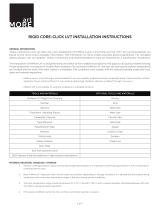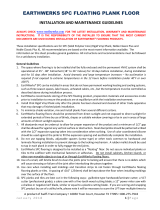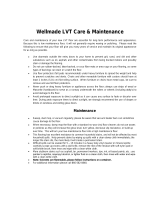
WARRANTY COVERAGE
Manufacturing Defect: During the period of the warranty, this product will be free from manufacturing defects.
Wear Resistance: During the period of the warranty, this product’s wear layer will not wear through to the decora-
tive layer under normal use. Excessive wear due to improper maintenance or care is not a defect in the wear layer
or product.
What is NOT Covered by this Warranty (item list is not exhaustive)
• Improper Installation: Material installed that is not installed in accordance with Installation
Instructionsis not a manufacturing related defect. Installer workmanship is not warranted. Labor cost
to repair or replace material installed with visible imperfections Improper maintenance, which results in
loss of gloss level.
• Damage resulting from use of strong detergents, chemicals, paints, dyes, mats, fertilizers, or other
similarmaterials.
• Damage caused by moving appliances or heavy furniture without protecting the oor. (Always protect
oor by using protective covering when moving heavy objects.
• Damage or scratches resulting from accidents, casualty events, abuse or improper usage (includingdam
age from pet claws, teeth, urine etc.). Accidents, abuse and improper usage are dened as, but arenot
limited to damage caused by: casters on furniture, rotating beater bars on vacuum cleaners, burns,cuts,
impact from heavy and sharp objects, narrow or spike heels, cleats, etc., as well as, damageresulting from
unprotected furniture legs.
• Damage caused by leaks from appliances or plumbing.
• Construction damage after installation.
• Installation-related errors or damage including improper conditioning of jobsite and ooring materials.
• Fading, discoloration, or other damage due to excessive temperatures or sunlight. Radiant heat must not
exceed 85 ° F (29°C) and be approved by the manufacturer for the use of their product with resilientvinyl
ooring applications.
• Problems or damage due to excessive moisture or hydrostatic pressure from the sub-oor.
• Discoloration caused by use of latex or rubber-backed oor mats. Note: some synthetic backed carpets
contain latex in the manufacturing process that may discolor vinyl. Always use mats marked as
“nonstaining.”
• Discoloration caused by rubber pads, rubber wheels, rubber tires, rubber rollers, automotive tires, etc.
• Flooring installed on stairs is excluded from warranty coverage.
• Installation of residential product in a commercial environment.
msisurfaces.com
Page 5









